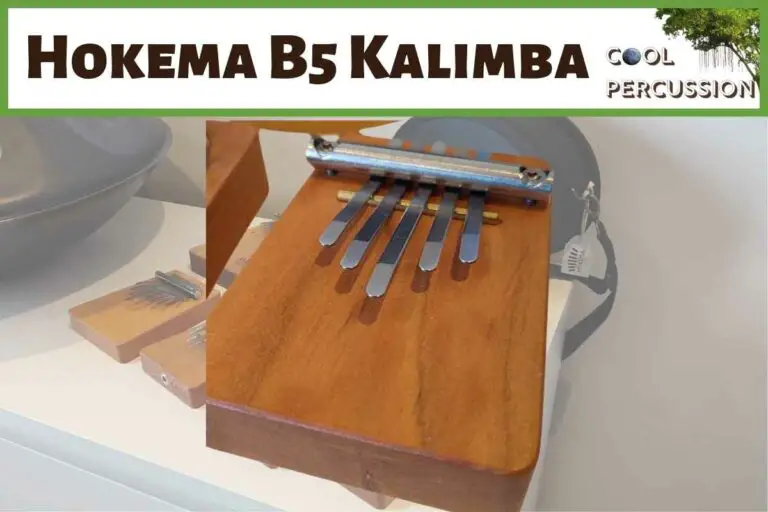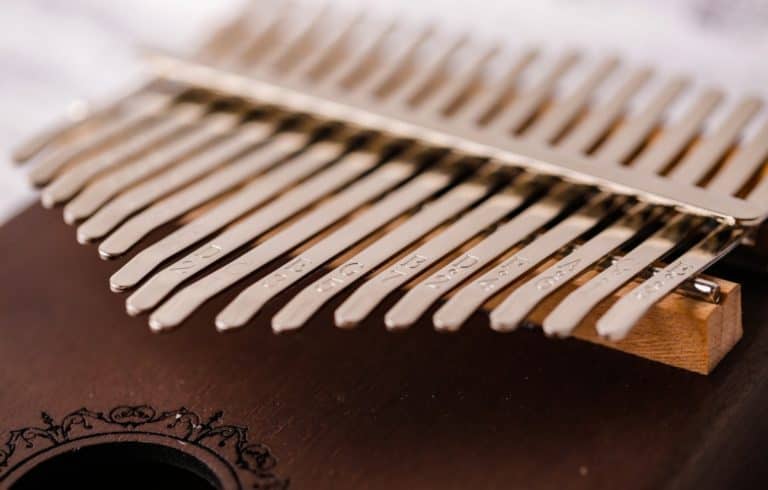What is a Chromatic Kalimba and Why You Might Want One
A chromatic Kalimba is different from standard kalimbas you may already be aware of. They have more tines and notes and tuned to a different scale. They are more closely related to the original African Mbira which were the inspiration for this largely unknown but well-loved percussion instrument. So let’s find out: What is a chromatic Kalimba?
A chromatic Kalimba has additional tines, often positions on the back of the instrument with the chromatic keys. The chromatic notes do not fit into the key scale of the instrument but can be used to create unique melodies.
Let’s find out more about Chromatic Kalimbas, types, and where you can buy them and what to expect to pay.
The different types of notes on a chromatic kalimba
A chromatic kalimba is a kalimba with more notes on it, allowing for a more flexible and adaptive range of tunes you can play with the little thumb piano!
On the other hand, the chromatic version of the kalimba is an awful lot more difficult to operate than a regular kalimba. These are great instruments for people who feel proficient enough with their kalimba to move on to the next level and want to play more complex phrases, songs, and melodies.
The tines on a chromatic kalimba are tuned to the same note as those of an acoustic piano, which is what gives it its name. This means that you can play melodies in any key and not just one or two specific keys like with other types! As well-tuned instruments go this makes for some really beautiful music when played correctly by someone who knows how these things work – even if they’re new at playing them themselves too…
It’s also worth noting here though: there will be more notes than your regular thumb pianos have available so don’t expect all tunes from classical repertoire (or most songs) to be playable without modification first either because sometimes only certain combinations make sense due do their tuning system limitations.
Another great use-case for the chromatic kalimba is for the more accomplished Kalimba players who are looking to get involved in playing thumb pianos. Chromatic kalimbas have more possible notes available to play, whereas normal kalimbas do not.
This makes the expanded chromatic option a great one for more experienced musicians, as they can utilize the additional versatility of the chromatic version.
If you want to learn more about this delightful version of the thumb piano, read on as we comprehensively break down what a chromatic kalimba is and how to use it!
So let’s find out how that tuning is different from standard.
Why is a chromatic Kalimba tuned differently to a standard one
Due to the unique combination and alignment of the different keys on the kalimba, these instruments are tuned in a very distinct way.
A lot of kalimbas do not have enough keys on them to be able to accommodate all the possible notes, so are tuned to a musical scale, as opposed to just having every note possible.
The kind of scale a normal, more diminutive kalimba would be tuned to is called a “diatonic scale”. Simply put, the kalimba is tuned so that striking every note in sequence will produce a naturally harmonic and pleasing sound – making it incredibly easy to make great music.
Furthermore, scales are arranged in such a way that most of the notes work well in tandem with each other, so it is a great instrument to just pluck away at and make some great sounding music!
Kalimbas will most commonly be tuned to a particular diatonic scale (and musical key), for example, the C major or G major scale being the most common tunings new kalimbas are supplied in. This makes them like harmonicas in a way, which are also tuned to one specific key.
A chromatic kalimba is tuned to a full 12-note scale, which means that it has the same notes as an octave on any standard piano. This makes them like harmonicas in another way – they are tunable across all keys!
The benefit of this tuning system over other types (such at diatonic) comes from its flexibility and ability for more experimentation with different sounds; you can play up or down through each note without having too many clashes between two adjacent tines when changing key signatures.” Chromatically” refers not only just how far apart one set string’s pitch will be relative than others but also about their relationship against “diatonics”.
What is a Chromatic Scale?
First off, when we say “chromatic” in the context of a kalimba, we are not referring to color. That is typically what the word means, but in this instance we are talking about musical scales (which you can read more about in another of our articles).
In short: A Chromatic scale is one that plays every single note between two different points on a key. For example, a C chromatic scale would contain the notes C, C sharp, D, D sharp, E, F, F sharp, G, G sharp, A, A sharp and B.
A chromatic kalimba is one that has been tuned to play a Chromatically. That means, it will be able not only just how far apart the pitch of each note on its tines are from other notes but also their relationship against “diatonics”. This tuning allows for more sounds and melodies than what you would find in traditional African thumb pianos or standard Western 12-tone scale instruments like guitars.
The benefits? You’ll get access over an entire range scales – including those with sharps (#) as well flats (-), which can give your music some new colors! And if there’s any key signature changes throughout our songwriting process then this instrument won’t suffer
My Favourite Kalimbas for Beginners
I own quite a few Kalimbas of differing sizes, keys, styles, and prices. I was somewhat addicted for a while! Anyway, having gone through quite a few when I first started getting interested, I have a couple of recommendations for you, if you are looking to buy your first, so you can try one out inexpensively and see if you want to take things further
Chances are, you’ll stick with one of these as you can learn and grow with them, which is why I’ve picked them out
Gecko Kalimba
This was the first-ever Kalimba I bought and it is the one I use the most today.
Because it is so gorgeous looking, I have mine on display in the office.
Hluru Board Kalimba
One thing that you might be slightly surprised about is that you can gain a richer sound from the board kalimba as opposed to the Box.
They are also a little easier to play if you do not have big hands because the depth is much shallower
What are the benefits of a chromatic Kalimba?
This incredibly wide range of different sounds a chromatic kalimba can make is where it really shines.
Chromatic kalimbas do not inherently sound better than regular kalimbas. Usually, chromatic kalimbas will have the “black” keys from piano (all of the sharps, flats and accidentals) on the reverse side, to be played by your fingers.
This allows you to do much more justice to pieces like Carol of the Bells or play more intricate pieces like The Entertainer.
Another fun component of the chromatic kalimba is that due to the construction this type of instrument, the extra tines add more resonance.
Part of the draw of the kalimba is the gorgeous, resonant chimes made by the plucking of each tine.
This is because the kalimba (and the wider mbira family) are “idiophonic” instruments. Idiophones are instruments where the noise comes primarily from the vibration of the instrument itself. When you play a kalimba, most of the sound you are hearing is not from the sound hole, but the vibration of the tone-wood and the tines themselves.
Consequently, adding a whole new row of metal tines is only going to amplify the iconic resonance a kalimba has.
So, if you are looking for an instrument that is both more complex and more resonant than the regular diatonic kalimba, the chromatic variant might be the one for you!
How to Play a Chromatic Kalimba
You play a chromatic kalimba in just the same way as you would a normal one, but you will need to develop additional dexterity with the notes on the rear of the instrument.
As with learning to play any musical instrument or percussion family instrument, practice makes perfect. most of the time.
Spend some time with the chromatic kalimba and you will soon be able to play it like a pro!
The following is an example of how one might learn scales on this instrument. The notes are written in order, from low-to-high: C D E F G A B (C)D(E)(F), etc… You can also use your fingers as well for each note if needed – just make sure that they don’t overlap too much or else there won’t any sound come out at all.
Summary
The chromatic kalimba is a fun and versatile instrument that can be used for many different types of music. It has the same basic shape as an African thumb piano, but with extra notes on its tines to make up all 12 keys in Western Music Theory (C D E F G A B C).
The tuning makes this perfect if you want play melodies more easily than those found by playing just one note at time like other instruments.
I hope this introduction to Chromatic Kalimbas has been helpful and answered any questions you had.
Now all you need do is find where you can buy one, and get started. Expect to pay a little more for a chromatic Kalimba than you would for the standard types you find on Amazon. But you do get extra notes, versatility, and ultimately, enjoyment from a chromatic kalimba in your possession.








